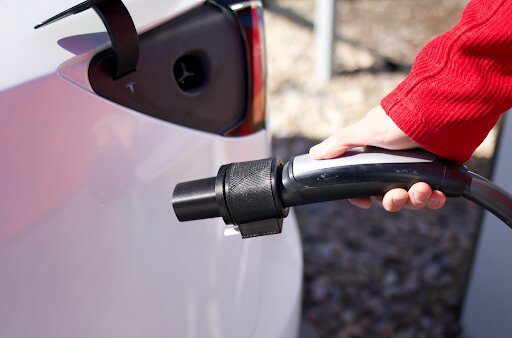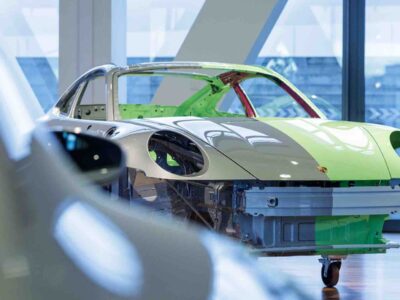Picture this: it’s late at night in a big city. You’re an Uber driver burning the midnight oil in your Tesla. The rides have been good, but you realize you need a charge. Unfortunately, there isn’t a charging station nearby.
Wouldn’t it be nice to drive away from the area without getting out and unplugging the charger? A new EV accessory from EVject, a charging solutions provider, is offering such an answer.
How It Works
The EVject adapter is attached to a charger’s head before being plugged into the port. Drivers can sit back in their charging cars, and should anything arise, they can pull away from the station. The EVject head is designed to fall off while protecting the cord, the EV’s port, and the driver. It was launched on April 5 and is now available for pre-order. The product is currently only compatible with Teslas, but the company is working on versions for other vehicles.
A group of transportation tech entrepreneurs came up with the idea of EVject following a YouTube video from Now You Know, a product-testing channel.
Two friends tested various electric vehicle (EV) charging adapters designed to disconnect the cables without having to exit the EV. The video scenario — and it is a wild one, to say the least — pits the idea of a bear hightailing it toward a Tesla. The more real-life scenario is locating a charger in sketchy areas.
“Many charging stations are located in dark, isolated, and potentially unsafe areas, often making drivers feel unsafe while charging their vehicle,” said Erick Vega, CEO of EVject, in a statement.
Research And Development
Kreg Peeler, president of EVject, discussed with The Business Download: Clean Energy how such a product came to fruition. He said the inspiration for EVject came as he developed more autonomous charging and self-driving technology through other ventures. He compared it to the computer boom in the 80s and 90s, with companies like Microsoft and Dell producing the primary product (i.e., computers) but secondary businesses like Logitech and Belkin making accessories (i.e., mouses, keyboards, monitors, etc.).

“I think there’s going to be really an explosion of those types of companies that are going to be creating this supportive technology for the EV revolution,” Peeler said. “By 2030, we’ll see about 10 times the EVs that we have on the road today. I think for the consumer to adopt EVs, we’re going to have to make it a lot more safe, a lot more.”
Research and development (R&D) for EVject began in the summer of 2021. The prototype was called the Pop-it Socket, a play on the Rocket Socket autonomous EV charger, another venture Peeler is involved in.
The Pop-it Socket had a key fob that could remotely disconnect the charger from the port. But if you own a Telsa, you don’t have any keys, so it’s easy to lose. So, Peeler and his team focused on creating a passive, mechanical device that could be easily detached.

“We wanted a device that doesn’t require any onboard electronics,” Peeler commented on EVject’s R&D. They also wanted a device that could be universal to all EV chargers, not just Tesla Superchargers, so more variations have been introduced.
So far, Peeler has patented eight different products, including EVject. He says he has 16 more pending. The COVID-19 pandemic slowed the rate of applications, allowing for more R&D on these products and autonomous EV technology from his company, Mōdal. It also put his patents at the top of the pile, earning approval quickly. The goal is to get more patented autonomous charging and self-driving products by 2025.
“We actually have a solution we think is better than any of the adapters and better than manual plugging in. Plugging into the side of the car where the gas spout is doesn’t make any sense,” Peeler explained. “We think it should be charging from underneath the car, and humans shouldn’t be required to plug it in. We have a bunch of patents around those designs.”
Charging Anxities Eased
Charging station safety is a paramount concern for EV owners. Many are located off central streets, meaning fewer people are around. Even simple things like someone disconnecting an EV as a prank can cause serious problems. EVject eases some of the tension about powering at night, splitting in half when the driver inches forward. The metaphor to describe the action is “like Legos fitting over each other.”
When the device splits apart, the electric current is cut off entirely. “The only thing we’re doing is bypassing the communication pins, which tells the Tesla to stop charging and disconnect the electronics,” Peeler explained.
So, there is no worry about getting shocked or damaging the port or charger.
While drivers still need to be aware of there surroundings and alert, the EVject adapter can offer a viable solution to solving some of the biggest qualms of night charging.
“You know, I’ve got a daughter who turns 16 in a couple of weeks, and if I ever let her borrow my car for a road trip, I would be concerned about her parking in an abandoned parking lot and sitting there for 30 minutes by herself and having no option to drive away,” Peeler expressed. This sentiment is a valid point, for sure, adding to why EVject was designed for these scenarios.





